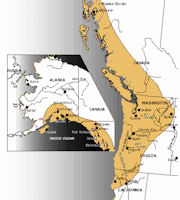Pacific Northwest - Mountains
 Although the coastal mountains provide some protection and winds are generally lower in the summer, high winds can reach the eastern portions of the region even in the summer. When they do, the danger of fire is worsened. Few places in the Pacific Northwest do not offer a view of neighboring mountain peaks when the weather is clear.
Although the coastal mountains provide some protection and winds are generally lower in the summer, high winds can reach the eastern portions of the region even in the summer. When they do, the danger of fire is worsened. Few places in the Pacific Northwest do not offer a view of neighboring mountain peaks when the weather is clear.
Mount McKinley at the region's northern extremity is, at 6,200 meters, the highest in North America. The peaks of the Coast Range of Oregon are fairly continuous in that state, with elevations reaching about 1,200 meters. In Washington they are discontinuous, with several rivers, notably the Columbia and the Chehalis, cutting pathways across them. Coast Range elevations in Washington are seldom above 300 meters.
The Klamath Mountains of northern California and southern Oregon offer a jumbled topography. Little pattern is apparent in the terrain. This is a wild, rugged, empty area. The lowlands of Oregon are part of a structural trough that was created when that area sank at the same time that the Cascades to the east were elevated. This trough extends northward in the form of straits separating Canada's Vancouver Island from the rest of British Columbia, then passes through the complex of islands that line the Alaska Panhandle and provides the Inside Passage north as far as Juneau.
Farther inland, the Cascades extend from the Klamath Mountains northward into southern British Columbia. The southern section of these mountains appears as a high, eroded plateau topped by a line of volcanic peaks. Between Mount Lassen in California (one of the few volcanoes in the United States to have been active in historic time) and Mount Hood in Oregon, these peaks are especially splendid in their isolation above the surrounding plateaus.
The northern Cascades are more rugged and have long proved a difficult barrier to movement eastward from the populous Puget Sound lowland. Here, extinct volcanoes, most notably Mount Rainier, provide the highest elevations and best defined peaks. Beyond the Alaska Panhandle and the massive, glacier-covered St. Elias Mountains, the mountains divide in southern Alaska. The Coast Ranges, notably the Chugach and Kenai Mountains, decline in elevation from east to west.
The interior mountains, the Alaska Range, are much higher and more continuous. A large lowland at the head of Cook Inlet is south of a gap through the Alaska Range, and here Anchorage, easily the largest city in Alaska (with an estimated population of 226,000 in 1993), is located around its good harbor and with easy connection to the interior. Juneau, the capital of Alaska, is located on a narrow coastal lowland on the Panhandle; its only transportation connections to the rest of the state are by air or water. The farthest one can drive from town is about 15 kilometers.
This location for the capital was reasonable when Alaska's wealth was in the Panhandle's forests and salmon fisheries and when access to the Yukon gold fields through Skagway was a consideration. As the state's economy changed and other resources became more important, the Panhandle languished. Fairbanks (with an estimated population of 32,300 in 1989), in central Alaska, and Anchorage, which is accessible to the southern portion of the state, outstripped Juneau in population growth; the capital city still had fewer than 29,000 people in 1989.
In terms of vegetation, there are magnificent redwood stands in the Klamath Mountains; Douglas fir, hemlock, and red cedar in Washington and Oregon; and Sitka spruce on the Alaska peninsula. This is a land not just of forest, but of beautiful expanses of tall trees reaching straight for the sky. Except for the drier lowlands, where the normal vegetation of the Willamette Valley is prairie grass and that of the land east of the Cascades a mix of grass and desert shrub, and except for the tundra above the tree line, all of the Pacific Northwest is, or was, covered by forest. Tree growth is encouraged by plentiful moisture and moderate winter temperatures. Forest products were long the economic mainstay of the region. Even today, while the southeastern United States produces more wood for pulp and paper products, no other part of the country provides as much lumber as the North Pacific Coast.
|
NEWSLETTER
|
| Join the GlobalSecurity.org mailing list |
|
|
|

